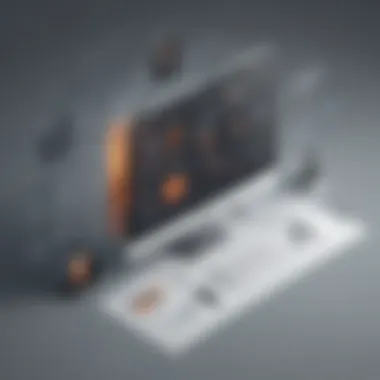Unveiling the Role of an Ecommerce Graphic Designer: A Detailed Exploration


Tech Trend Analysis
Product Reviews
Moving beyond theoretical explorations, this guide ventures into concrete product reviews, dissecting the intricacies of tools and software poised to redefine ecommerce graphic design. Offering a meticulous overview of leading products in the market, each review meticulously breaks down the features and specifications that differentiate them. By conducting performance analyses, readers gain insights into the practical applications of these products, understanding their efficacy in real-world scenarios. Balancing the scales, a careful examination of the pros and cons provides a nuanced perspective, enabling informed decision-making. Finally, tailored recommendations serve as guiding beacons, aiding readers in selecting the most suitable tools to elevate their design endeavors.
How-To Guides
Equipping readers with practical insights, this section transitions into detailed how-to guides that serve as practical blueprints for mastering the nuances of ecommerce graphic design. Commencing with an insightful introduction to the topic, it lays a robust foundation by contextualizing the importance of each guide. Step-by-step instructions unravel the complexities, making seemingly daunting tasks accessible and achievable. Furthermore, sprinkled with tips and tricks accrued from industry experts, readers glean insider knowledge to enhance their skill set. Inevitably, even the most astute professionals encounter challenges, and hence, comprehensive troubleshooting segments offer remedies to common pitfalls, ensuring a seamless design experience.
Industry Updates
In its pursuit of presenting a holistic view, this guide encapsulates recent developments in the tech industry that reverberate throughout ecommerce graphic design. Delving into the pulse of market trends, it provides a comprehensive analysis of how industry shifts resonate with businesses and consumers alike. By dissecting these updates, readers glean a profound understanding of the current ecosystem, appreciating the key dynamics that steer the industry's helm. Deliberating on the impact of these changes, the section illuminates the strategies businesses can adopt to navigate the ever-evolving terrain of ecommerce graphic design, fostering an environment of adaptation and innovation.
Introduction
In the vast landscape of ecommerce, graphic design emerges as a pivotal element shaping digital aesthetics. As businesses navigate the online realm, the role of an ecommerce graphic designer becomes increasingly crucial. This section serves as a gateway to understanding the intricate realm of ecommerce graphic design, shedding light on its significance, complexities, and ever-evolving nature.
Defining Ecommerce Graphic Design
Ecommerce graphic design encompasses the art of creating visually compelling digital assets tailored for online platforms. It involves the strategic amalgamation of artistic elements with technical proficiency to craft engaging visual experiences that resonate with the target audience. From designing website banners to curating product images and crafting social media graphics, ecommerce graphic design weaves a tapestry of visual narratives aimed at enhancing brand visibility and customer engagement.
Significance of Graphic Design in Ecommerce
The significance of graphic design in ecommerce transcends mere visual appeal; it plays a fundamental role in driving brand recognition, fostering customer trust, and maximizing conversion rates. In the digital realm where attention spans are limited and competition is fierce, compelling visual storytelling through graphic design serves as a powerful tool for capturing and retaining consumer interest. By leveraging design principles to create a cohesive brand identity across various digital touchpoints, ecommerce graphic designers lay the foundation for brand differentiation and customer loyalty.
Core Responsibilities of an Ecommerce Graphic Designer


In this article, we delve into the fundamental aspect of the job role for an ecommerce graphic designer. The core responsibilities of an ecommerce graphic designer hold immense importance in the realm of e-commerce due to their pivotal role in shaping the visual representation of a brand. These responsibilities encompass creating visually appealing assets, maintaining brand consistency, and collaborating closely with marketing teams. Each of these responsibilities plays a crucial part in enhancing the overall user experience and brand identity within the competitive e-commerce landscape.
Creating Visual Assets
Designing Website Banners
Designing website banners is a critical aspect of an ecommerce graphic designer's role as it serves as the virtual storefront of an online brand. These banners are the first point of visual engagement for website visitors, making them essential for capturing attention and conveying brand messaging effectively. The key characteristic of designing website banners lies in striking a balance between aesthetics and functionality. By creating visually captivating banners that also drive conversions, designers can significantly impact the success of an e-commerce platform. While the unique feature of website banners is their ability to communicate brand values in a concise visual format, designers must be mindful of creating responsive banners optimized for various devices to ensure a seamless user experience.
Developing Product Images
The development of product images is a vital component of showcasing products in the e-commerce sector. High-quality and visually appealing product images are instrumental in enticing customers and fostering trust in the quality of products offered. The key characteristic of product images is to showcase products from different angles and highlight key features to facilitate informed purchasing decisions. By focusing on creating clear, detailed, and aesthetically pleasing product images, ecommerce graphic designers contribute significantly to increasing sales and enhancing the overall shopping experience. However, a potential disadvantage of product images is the time and effort required to consistently update and maintain a visually cohesive product catalog across an e-commerce platform.
Crafting Social Media Graphics
Crafting social media graphics plays a crucial role in enhancing brand visibility and engagement across various digital platforms. The key characteristic of social media graphics is their ability to communicate brand messages concisely and creatively in a visually competitive online space. By creating shareable and engaging graphics, designers help amplify brand reach and attract a wider audience on social media. The unique feature of social media graphics lies in their potential to evoke emotions and drive audience interaction, thus fostering a sense of community around the brand. However, a challenge in crafting social media graphics is maintaining consistency across different platforms while tailoring content to suit the specific audience demographics.
Maintaining Brand Consistency
The maintenance of brand consistency is paramount for an ecommerce graphic designer to ensure that all visual elements adhere to the established brand identity guidelines. Consistency across various touchpoints instills brand recognition and trust among consumers, contributing to a cohesive brand image. By maintaining brand consistency in design elements such as color schemes, typography, and imagery, designers reinforce brand recall and loyalty among audiences. However, the challenge lies in balancing creative innovation while adhering to brand guidelines to avoid diluting brand identity.
Collaborating with Marketing Teams
Collaboration with marketing teams is essential for an ecommerce graphic designer to align visual assets with the overall marketing strategy and brand messaging. By working closely with marketing professionals, designers gain valuable insights into consumer preferences and market trends, enabling them to create targeted and impactful visual content. The key to successful collaboration lies in effective communication, understanding marketing objectives, and adapting design strategies to support campaign goals. However, challenges may arise in coordinating timelines and priorities between design and marketing teams to ensure seamless integration of visual assets within marketing campaigns.
Essential Skills for Ecommerce Graphic Design
In the realm of ecommerce graphic design, possessing a robust skill set is paramount for professionals seeking success in this dynamic field. The integration of essential skills is foundational to delivering visually appealing and effective digital experiences for online audiences. These skills serve as the building blocks for creating captivating designs that resonate with consumers and drive engagement on ecommerce platforms. Understanding the importance of honing these essential skills is crucial for individuals aspiring to excel in the demanding landscape of ecommerce graphic design.


Proficiency in Graphic Design Software
One of the fundamental pillars of ecommerce graphic design is proficiency in graphic design software. Mastery of tools such as Adobe Photoshop, Illustrator, and In Design is indispensable for creating stunning visual assets that elevate brand identity and capture the attention of online shoppers. Through proficient utilization of these software tools, graphic designers can bring their creative visions to life, manipulating images, graphics, and typography with precision and finesse. The ability to navigate complex interfaces and leverage advanced features empowers designers to craft aesthetically pleasing designs that align with client goals and brand aesthetics.
Understanding of User Experience (UX) Principles
Another essential skill for ecommerce graphic designers is a deep understanding of user experience (UX) principles. Effective graphic design goes beyond aesthetics; it must also prioritize functionality and usability to deliver seamless user interactions. By comprehending UX principles such as intuitive navigation, visual hierarchy, and responsive design, designers can optimize the digital journey for customers, enhancing user satisfaction and conversion rates. Integrating UX principles into graphic design practices ensures that designs are not only visually appealing but also user-centric, facilitating positive user experiences across ecommerce platforms.
Knowledge of Web Design Fundamentals
Equally essential for ecommerce graphic designers is a solid foundation in web design fundamentals. Understanding the intricacies of website layouts, grid systems, and responsive design is instrumental in creating designs that are optimized for online environments. Proficiency in HTML, CSS, and web development technologies enables designers to collaborate effectively with developers, ensuring seamless implementation of their design concepts on digital platforms. By upholding web design best practices and staying abreast of industry trends, graphic designers can tailor their skills to meet the evolving demands of the ecommerce landscape, delivering impactful visual solutions that resonate with online audiences.
Qualifications and Experience
For an ecommerce graphic designer, having the right qualifications and experience is crucial for excelling in this competitive field. In this comprehensive guide, we emphasize the vital role that qualifications and experience play in shaping a successful career in ecommerce graphic design.
Educational Background
A solid educational background sets the foundation for an ecommerce graphic designer's career. The educational qualifications not only provide the necessary knowledge foundation but also demonstrate a level of commitment to the field. Having a degree in graphic design or a related field equips designers with essential skills such as design principles, color theory, and software proficiency. Moreover, specialized courses or certifications in areas like web design or UX design can enhance the designer’s expertise quotient and make them more attractive to potential employers.
Relevant Experience
Experience in the field of ecommerce graphic design is invaluable. Real-world projects and hands-on experience allow designers to apply theoretical knowledge in practical scenarios, honing their skills and problem-solving abilities. Working on different projects helps designers understand varying client requirements and industry trends. Whether through internships, freelance projects, or full-time positions, gaining relevant experience enables designers to build a diverse portfolio showcasing their capabilities to prospective clients or employers.
Portfolio Showcase
A portfolio serves as a visual testament to an ecommerce graphic designer's skills and capabilities. It acts as a showcase of past projects, demonstrating design style, creativity, and versatility. A well-curated portfolio not only highlights one’s best work but also tells a story of growth and evolution as a designer. Including a variety of projects such as website designs, branding elements, social media visuals, and product images allows potential clients or employers to assess the designer’s range and expertise. Building a strong portfolio is an ongoing process that requires continually updating with new projects and refining existing ones to reflect current design trends and personal growth.


Challenges Faced by Ecommerce Graphic Designers
Adapting to Rapid Technological Changes
Adapting to Rapid Technological Changes is a critical aspect within the challenges faced by ecommerce graphic designers. In today's digital age, technology evolves at a breakneck pace, influencing design trends and tools. Designers must continually update their skills and knowledge to remain competitive in the ever-changing ecommerce environment. This subsection will explore the impact of technological advancements on graphic design practices, emphasizing the importance of embracing innovation and adaptation to stay ahead in the field.
Meeting Tight Deadlines
Meeting Tight Deadlines stands out as a prominent challenge for ecommerce graphic designers, given the fast-paced nature of the industry. Design projects often come with strict timelines and high expectations, requiring designers to deliver quality work within limited time frames. This section will delve into the strategies and techniques designers can employ to manage their time effectively, prioritize tasks, and meet deadlines without compromising on creativity or quality.
Balancing Creativity and Brand Guidelines
Balancing Creativity and Brand Guidelines poses a significant challenge for ecommerce graphic designers, as they must infuse innovation into their work while adhering to brand identity and guidelines. Striking a harmonious balance between creative expression and brand cohesiveness is essential to convey the right messaging and resonate with the target audience. This subsection will explore how designers can navigate this delicate balance, leveraging creativity to enhance brand visibility while maintaining consistency and integrity in design executions.
Career Growth and Development
Career growth and development are pivotal aspects to consider in the realm of ecommerce graphic design. A successful ecommerce graphic designer must continuously strive for advancement and enhancement in their skills and expertise. This journey of progression not only benefits the individual but also contributes positively to the overall quality and innovation within the ecommerce industry.
Career growth provides professionals with the opportunity to explore new horizons, delve deeper into specialized areas, and elevate their status within the field. As the digital landscape evolves rapidly, staying abreast of emerging trends and technologies is paramount for long-term success. Furthermore, development initiatives help individuals adapt to changing consumer behaviors and market dynamics, ensuring relevancy and competitiveness.
Moreover, setting career goals and milestones is essential for tracking progress and maintaining motivation. By embracing a culture of continuous learning and improvement, ecommerce graphic designers can position themselves as top-tier professionals in a dynamic and competitive market. Engaging in ongoing skill development and expanding one's knowledge base not only enhances job satisfaction but also opens up avenues for higher remuneration and recognition.
Conclusion
The Conclusion section of this comprehensive guide on 'Unveiling the Role of an Ecommerce Graphic Designer' serves as a pivotal endpoint, summarizing the core insights and key takeaways from the preceding discussions. It encapsulates the fundamental significance of ecommerce graphic design in the modern business landscape. By underscoring the critical role that graphic designers play in shaping digital experiences, this final segment crystallizes the essence of their contributions. Moreover, the Conclusion segment acts as a reflective mirror, allowing readers to absorb the collective knowledge shared throughout this guide and comprehend the broader implications of graphic design in the realm of e-commerce. It solidifies the connection between design aesthetics and commercial success in the digital realm, reinforcing the notion that graphic design is not merely a visual element but a strategic asset for online businesses.
Summarizing the Ecommerce Graphic Designer Role
In this section, we delve into the multifaceted role of an ecommerce graphic designer, emphasizing the versatile skill set and talents required to thrive in this dynamic field. From creating visually captivating assets to maintaining brand consistency, ecommerce graphic designers are the architects of visual storytelling in the e-commerce domain. Their ability to harmonize creativity with strategic objectives sets them apart as indispensable assets in the digital marketplace. By blending technical proficiency with artistic flair, graphic designers breathe life into online brands, fostering engagement and loyalty among modern consumers. This subsection sheds light on the intricate responsibilities that define the daily workflow of ecommerce graphic designers, showcasing their ability to blend innovation with commercial imperatives.
Emphasizing the Impact of Graphic Design in Ecommerce
The Impact of Graphic Design in Ecommerce segment unravels the profound influence that visual aesthetics wield in the realm of online commerce. From enhancing user experience to establishing brand identity, graphic design serves as a potent catalyst for driving customer engagement and loyalty. By crafting visually compelling narratives, ecommerce graphic designers evoke emotions, trigger actions, and elevate brand recall in saturated digital environments. This section highlights the symbiotic relationship between graphic design and business success, underscoring the pivotal role that design aesthetics play in shaping consumer perceptions and purchase decisions. Through a strategic amalgamation of creativity and market acumen, graphic designers elevate e-commerce platforms into immersive digital destinations that resonate with discerning audiences.



